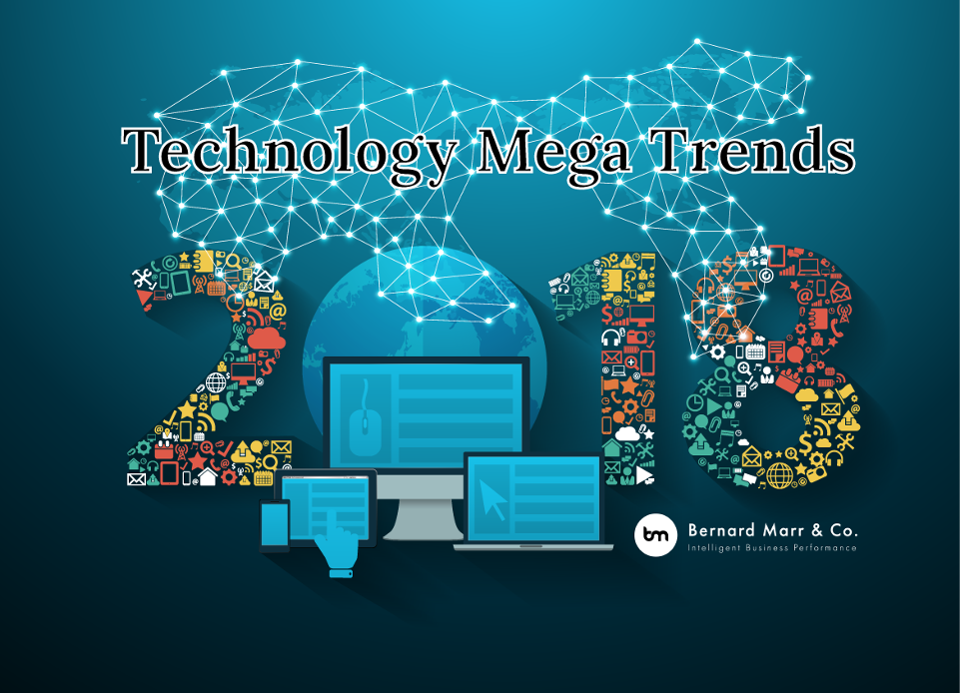5 Tech Trends – Some tech trends fizzle out and die a quiet death, while others are so significant that they transform our world and how we live in it. Here are the top nine tech mega-trends that I believe will define 2018 and beyond.
Trend 1: The increasing datafication of our lives
From chatting to friends in a messaging app or buying a coffee, to tapping in and out with an Oyster card or streaming music, today almost everything we do leaves a trail of data breadcrumbs. And this increasing datafication of our world has led to an unprecedented explosion in data.
Just in the average minute, Facebook receives 900,000 logins, more than 450,000 Tweets are posted, and 156 million emails and 15 million texts are sent.With numbers like that, it’s no wonder we’re essentially doubling the amount of data created in the world roughly every two years.
Trend 2: The Internet of Things (IoT) and how everyday devices are becoming more ‘smart’
The IoT – which encompasses smart, connected products like smart phones and smart watches –is a major contributing factor in this exponential increase in data. That’s because all these smart devices are constantly gathering data, connecting to other devices and sharing that data – all without human intervention (your Fitbit synching data to your phone, for instance).
Pretty much anything can be made smart these days. Our cars are becoming increasingly connected; by 2020, a quarter of a billion carswill be hooked up to the Internet. For our homes, there are obvious smart products like TVs,and less obvious ones, like yoga mats that trackyour Downward Dog. And, of course, many of us have voice-enabled personal assistants like Alexa – another example of an IoT device.
That’s already a lot of devices, but the IoT is just getting started. IHS has predicted there’ll be 75 billion connected devices by 2020.
Trend 3: Exponential growth in computing power is fueling massive tech advances
None of this incredible growth in data, nor the billions of IoT devices available,would be possible without the enormous leaps in computing power that we’ve made. Between 1975 and 2015, computing power doubled at a rate of every two years, before slowing to the current rate of approximately every two and a half years.
But we’re reaching the limits of what traditional computing power can handle. Thankfully, on the horizon, we have quantum computing. Probably the most significant transformation of computing power ever, quantum computing will see computers become millions of times faster than they are right now.Tech leaders are in a race to launch the first commercially viable quantum computer, capable of solving problems that today’s computers can’t handle. Capable, even, of solving problems that we can’t even imagine yet.
Trend 4: The incredible rise of artificial intelligence (AI)
Computers are now able to learn in much the same way as we humans do, and this leap in AI capabilities has been made possible by the massive increases in data and computing power. It’s the incredible explosion in data that has allowed AI to advance so quickly over the last couple of years; the more data an AI system has, the quicker it can learn and the more accurate it becomes.
This huge step forward in AI mean computers can now undertake more and more human tasks. In fact, it’s AI that allows computers to see (e.g. facial recognition software), read (e.g. analyzing social media messages), listen (e.g. Alexa standing by to answer your every command), speak (e.g. Alexa being able to answer you) and gauge our emotions (e.g. affective computing).
Trend 5: The unstoppable freight train that is automation
The more intelligent machines become, the more they can do for us. That means even more processes, decisions, functions and systems can be automated and carried out by algorithms or robots.
Eventually, a wide range of industries and jobs will be impacted by automation. However, for now, the first wave of jobs that machines are taking can be categorized using the four Ds: dull, dirty, dangerous and dear. This means humans will no longer be needed to do the jobs that machines can do faster, safer, cheaper and more accurately.
Beyond the four Ds, machines, robots and algorithms will replace – or augment – many human jobs, including professional jobs in fields like law or accounting. From truck drivers to bricklayers to doctors, the list of jobs that are likely to be affected by automation is surprising. One estimate reckons that 47 percent of US jobs are at risk of automation.
Information for this article was originally published by Bernard Marr on Forbes
We like to focus on the fifth tech trend, automation. Lower overhead costs by automating your business! Shoot us an email or give us a call at (605) 971-9555 for a free consultation.

